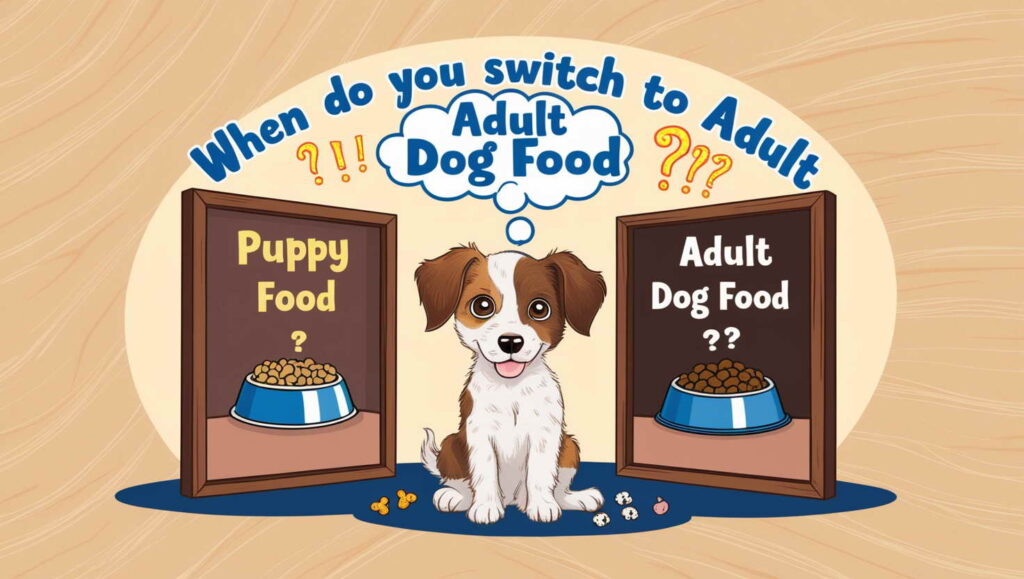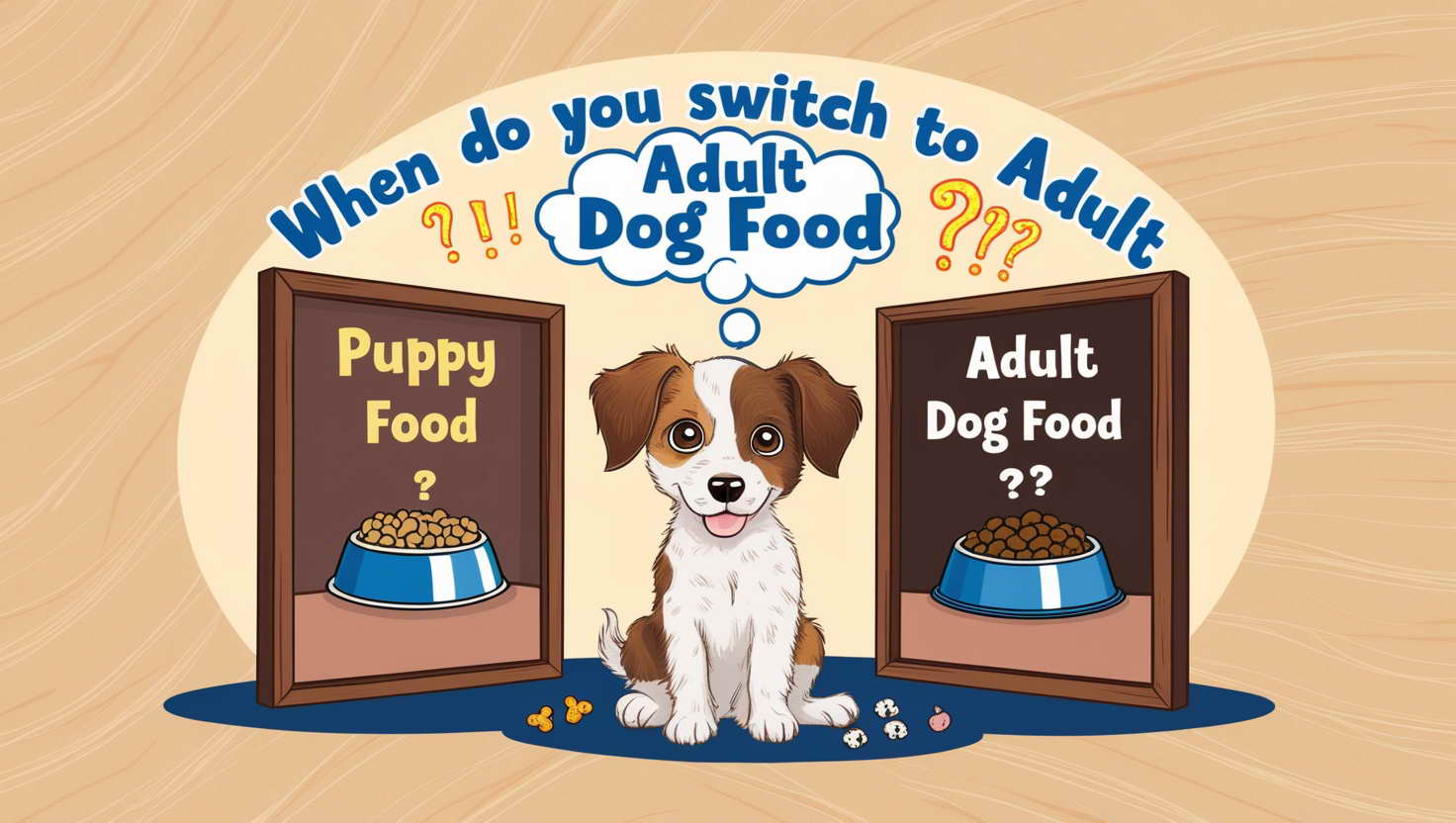
PETSIDI – Hey there, fellow dog lovers! As a musician who’s always on the road, I’ve had my fair share of experiences with furry friends. Today, let’s chat about a topic that’s crucial for every pup parent: when to make the switch from puppy chow to adult dog food. Grab a cup of coffee, and let’s dive in!
The Puppy to Adult Transition: It’s Not Just About Age
You might think it’s all about the candle count on your pup’s birthday cake, but there’s more to it than that. Let’s break it down:
- Breed size
- Growth rate
- Nutritional needs
- Activity level
These factors play a huge role in determining when your little furball is ready for the big leagues of adult dog food.
Small Breeds: The Speedy Gonzales of the Dog World
- Chihuahuas
- Yorkies
- Toy Poodles
These little dudes mature faster than you can say “puppy dog eyes“. They’re usually ready to switch to adult food around 9-12 months old. It’s like they’re on tour with a punk rock band – everything happens at lightning speed!
Medium Breeds: The Steady Rockers
- Beagles
- Cocker Spaniels
- Bulldogs
These guys are like the indie rock bands of the dog world. They take their time to mature, usually hitting adulthood around 12-14 months. They’re not in a rush, just grooving to their own beat.
Large Breeds: The Symphony Orchestra
- Labrador Retrievers
- German Shepherds
- Golden Retrievers
These majestic beasts are like a full symphony orchestra – they take time to reach their full potential. They usually make the switch to adult food around 15-18 months. It’s a long composition, but the result is worth the wait!
Giant Breeds: The Epic Rock Opera
- Great Danes
- Mastiffs
- Saint Bernards
These gentle giants are the rock operas of the dog world – grand, impressive, and taking their sweet time to fully develop. They might not be ready for adult food until they’re 18-24 months old. It’s like waiting for the next Tool album – it takes forever, but it’s epic when it finally happens!
Signs Your Pup is Ready for Adult Food
Now, let’s talk about the signs that your furry roadie might be ready to graduate to the adult menu:
- Slowing growth rate: Your pup isn’t gaining weight as rapidly as before.
- Reaching physical maturity: They’re looking more like an adult dog in body shape.
- Decreased appetite: They’re not inhaling their food like it’s the last meal before a world tour.
- Energy level changes: They might be less hyperactive and more settled.
The Transition Process: It’s Like Mixing a New Track
When you’re ready to make the switch, remember – it’s not about going cold turkey. You’ve got to ease into it, like introducing a new instrument to a familiar melody. Here’s a transition schedule that works like a charm:
| Day | Puppy Food | Adult Food |
|---|---|---|
| 1-2 | 75% | 25% |
| 3-4 | 50% | 50% |
| 5-6 | 25% | 75% |
| 7+ | 0% | 100% |
This gradual transition helps prevent any digestive distress – because nobody wants a dog with an upset stomach, especially not when you’re trying to write your next hit single!
Choosing the Right Adult Dog Food: It’s Like Picking the Perfect Guitar
Now that you know when to make the switch, let’s talk about what to switch to. Choosing the right adult dog food is like selecting the perfect guitar – it needs to suit your style and needs. Here are some factors to consider:
- Breed-specific formulas: Some brands offer food tailored to specific breeds.
- Activity level: A working dog needs different nutrition than a couch potato.
- Health concerns: Some foods address specific health issues like joint health or weight management.
- Ingredient quality: Look for real meat as the first ingredient and avoid artificial preservatives.
- Wet vs. dry food: Each has its pros and cons – consider mixing it up!
Raw Meat in Dog Food: A Controversial Chord
Now, let’s hit a slightly controversial note – raw meat in dog food. This topic is like jazz – some love it, some don’t get it, and everyone’s got an opinion. The idea of feeding dogs a raw diet, often called BARF (Biologically Appropriate Raw Food), has gained traction among some pet parents. Proponents argue it’s more natural and can lead to shinier coats, healthier teeth, and better digestion. But hold your horses (or should I say, hold your hounds?) – it’s not all smooth sailing.
Raw diets can be risky if not done right, potentially exposing your pup to harmful bacteria or nutritional imbalances. It’s like trying to compose a symphony without sheet music – it takes a lot of knowledge and careful planning. If you’re considering the raw route, it’s crucial to consult with your vet first. They can help you decide if a raw diet is right for your dog and guide you on how to do it safely. Remember, whether you’re feeding kibble, wet food, or raw meat, the goal is the same – keeping your furry bandmate healthy and happy!
The Importance of Proper Nutrition: It’s the Backbone of Your Dog’s Health
Just like a solid bassline is crucial for a great song, proper nutrition is the foundation of your dog’s health. Adult dog food is formulated differently from puppy food, providing:
- Balanced protein levels
- Appropriate calorie content
- Essential vitamins and minerals
Getting this right can help prevent issues like obesity, joint problems, and digestive issues. It’s like tuning your instrument – get it right, and everything else falls into place.
Common Mistakes to Avoid: Don’t Hit a Sour Note!
When making the switch to adult dog food, there are a few common mistakes to avoid:
- Switching too early: This can lead to nutritional deficiencies.
- Switching too late: This might result in obesity or other health issues.
- Changing food abruptly: This can cause digestive upset.
- Ignoring your dog’s individual needs: Every dog is unique, like every musician has their own style.
- Not consulting with your vet: They’re like your sound engineer – they know what’s best for your dog’s health.
The Role of Exercise: Keep the Beat Going!
Remember, switching to adult dog food isn’t just about the food itself. It’s also about maintaining a healthy lifestyle. Regular exercise is crucial for your adult dog, just like regular practice is essential for a musician. It helps:
- Maintain a healthy weight
- Promote good digestion
- Keep joints and muscles strong
- Provide mental stimulation
So, make sure to keep the rhythm going with plenty of walks, playtime, and maybe even a game of fetch between gigs!
Special Considerations: The Solo Artists of the Dog World
Some dogs might need special consideration when it comes to their diet:
- Pregnant or nursing dogs: They might need to stay on puppy food longer for the extra nutrients.
- Working dogs: They might benefit from high-performance adult dog food.
- Senior dogs: As they age, they might need to switch to a senior-specific formula.
These are the solo artists of the dog world – they march to the beat of their own drum and might need a custom approach to their nutrition.
Conclusion: It’s All About Harmony
In the end, switching your dog to adult food is all about finding the right harmony between their age, size, breed, and individual needs. It’s like composing the perfect song – all the elements need to work together.
Remember, every dog is unique, just like every musician has their own style. What works for one might not work for another. Always keep an eye on your furry friend’s health and behavior, and don’t hesitate to consult with your vet if you have any concerns.
So, there you have it – your guide to making the switch to adult dog food, from one dog-loving musician to another. Now, if you’ll excuse me, I’ve got a gig to get to, and my four-legged roadie is giving me the “it’s dinner time” look. Rock on, and happy feeding!

Leave a Reply